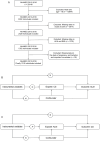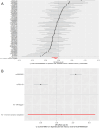Association Between Sarcopenia Susceptibility and Cesarean Section: A Study Based on National Health and Nutrition Examination Survey (NHANES) and Mendelian Randomization
- PMID: 40548312
- PMCID: PMC12182072
- DOI: 10.2147/IJWH.S526607
Association Between Sarcopenia Susceptibility and Cesarean Section: A Study Based on National Health and Nutrition Examination Survey (NHANES) and Mendelian Randomization
Abstract
Objective: To investigate the relationship between sarcopenia susceptibility and cesarean section (CS) and to assess causality using Mendelian randomization (MR).
Methods: Data from 1,316 individuals aged from 20-59 in National Health and Nutrition Examination Survey (NHANES) 2013-2016 were included in the study. The association between sarcopenia and CS was investigated by adjusting for confounders using multivariable linear and logistic regression analysis. Two-sample bidirectional MR was employed to evaluate causal relationships. Genetic data associated with CS (n=462,933) and appendicular lean mass (ALM, n=450,243) were sourced from the largest genome-wide association studies (GWAS). The primary analytical method used was inverse variance-weighted (IVW).
Results: Based on the cross-sectional study, the number of CS was positively correlated with sarcopenia across all adjusted models, whereas no such association was observed with vaginal delivery (VD). Subgroup analyses indicated that these associations were primarily evident among premenopausal women. IVW-MR analysis revealed a significant association between sarcopenia and CS (OR=0.989, 95% CI: 0.984 to 0.994, P<0.001), but there was no statistically causal link in reverse (OR=2.100, 95% CI: 0.012 to 364.040, P=0.779).
Conclusion: A significant positive correlation and potential causal relationship between sarcopenia susceptibility and CS were identified, which highlighted the need for increased attention to sarcopenia in women with a history or high likelihood of CS, including but not limited to muscle health assessments during prepartum and postpartum periods, along with necessary muscle-strengthening interventions.
Keywords: NHANES; cesarean section; gestational diabetes mellitus (GDM); menopause; sarcopenia.
© 2025 Tian et al.
Conflict of interest statement
The authors declare that they have no known competing financial interests or personal relationships that could have appeared to influence the work reported in this paper.
Figures




Similar articles
-
Association between thyroid function and type 2 diabetes mellitus based on the NHANES and Mendelian randomization study.Hormones (Athens). 2025 Jun 25. doi: 10.1007/s42000-025-00691-x. Online ahead of print. Hormones (Athens). 2025. PMID: 40560353
-
Maternal and neonatal outcomes of elective induction of labor.Evid Rep Technol Assess (Full Rep). 2009 Mar;(176):1-257. Evid Rep Technol Assess (Full Rep). 2009. PMID: 19408970 Free PMC article.
-
Genetically predicted the causal association between serum mineral elements with immune thrombocytopenia and Henoch-Schonlein purpura: a bidirectional two-sample Mendelian randomization analysis.Thromb J. 2025 Jun 16;23(1):65. doi: 10.1186/s12959-025-00756-2. Thromb J. 2025. PMID: 40524203 Free PMC article.
-
Association between sarcopenia and intervertebral disc degeneration: A bidirectional two-sample Mendelian randomization.J Back Musculoskelet Rehabil. 2025 Jul;38(4):902-913. doi: 10.1177/10538127251318926. Epub 2025 Apr 24. J Back Musculoskelet Rehabil. 2025. PMID: 40275698
-
Dietary advice interventions in pregnancy for preventing gestational diabetes mellitus.Cochrane Database Syst Rev. 2017 Jan 3;1(1):CD006674. doi: 10.1002/14651858.CD006674.pub3. Cochrane Database Syst Rev. 2017. PMID: 28046205 Free PMC article.
References
LinkOut - more resources
Full Text Sources

